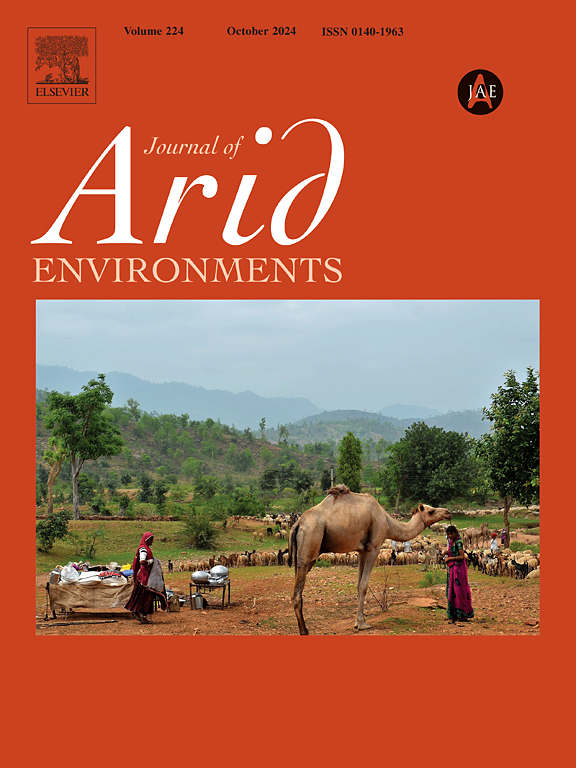Drought impact on the nutrients of forage plants in a semi-arid rangeland and its potential implications for sustaining herbivores
IF 2.6
3区 环境科学与生态学
Q2 ECOLOGY
引用次数: 0
Abstract
The impact of drought on the nutrient content of important natural forage plants in semi-arid rangelands is poorly understood. Most studies to date have shown that drought induced stress resulted in lower plant nutrient concentrations. The consequential declines in forage quality may be an important limiting factor in sustaining wild herbivore populations through periods of drought. In the semi-arid southern Kalahari of South Africa, the most severe drought recorded in the last 60 years resulted in high plant and animal mortalities. The aim of this study was to determine if the severe drought impacted the nutritional value of plants in this region and resulted in nutrient deficient forage. For this, the nutrient content of the most abundant woody and grass species was determined during the drought and the first year of above-average rainfall following the drought. The impact of drought differed markedly between dicotyledonous woody species and monocotyledon grasses. In the former, it resulted in decreased crude protein concentrations but increased macronutrient concentrations. In the latter, crude protein contents were higher and the content of most macronutrients lower. Despite these differences, the forage on offer to herbivores during the drought was not nutrient deficient. During the drought, the dry seasons when plant nutrients were naturally at their lowest, persisted for longer than normal. The prolonged dry seasons also resulted in shortened wet seasons, when plants were most nutritious. It was concluded that the prolonging of the period when forage quantity and quality is most limiting, is likely the main limitation in sustaining herbivores during periods of drought. More studies in semi-arid rangelands are however needed to better understand the impact of drought on plant nutrients in these systems.
干旱对半干旱牧场饲用植物养分的影响及其对维持草食动物的潜在影响
干旱对半干旱牧地重要天然牧草养分含量的影响尚不清楚。迄今为止,大多数研究表明,干旱诱导的胁迫导致植物营养物质浓度降低。由此导致的饲料质量下降可能是干旱时期维持野生食草动物种群的重要限制因素。在半干旱的南非喀拉哈里沙漠南部,发生了60年来有记录以来最严重的干旱,导致动植物死亡率很高。本研究的目的是确定严重干旱是否影响了该地区植物的营养价值,导致营养缺乏的饲料。为此,在干旱期间和干旱后降雨量高于平均水平的第一年确定了最丰富的木本和禾本科物种的营养含量。干旱对双子叶木本植物和单子叶禾本科植物的影响存在显著差异。前者降低了粗蛋白质浓度,但提高了宏量营养素浓度。后者粗蛋白质含量较高,多数宏量营养素含量较低。尽管存在这些差异,干旱期间提供给食草动物的饲料并不缺乏营养。在干旱期间,植物营养物质自然处于最低水平的旱季持续的时间比正常情况下更长。旱季的延长也导致了雨季的缩短,而此时植物是最有营养的。结果表明,牧草数量和质量最受限制的时期的延长可能是干旱时期维持草食动物的主要限制因素。然而,为了更好地了解干旱对这些系统中植物养分的影响,需要在半干旱的牧场进行更多的研究。
本文章由计算机程序翻译,如有差异,请以英文原文为准。
求助全文
约1分钟内获得全文
求助全文
来源期刊

Journal of Arid Environments
环境科学-环境科学
CiteScore
5.70
自引率
3.70%
发文量
144
审稿时长
55 days
期刊介绍:
The Journal of Arid Environments is an international journal publishing original scientific and technical research articles on physical, biological and cultural aspects of arid, semi-arid, and desert environments. As a forum of multi-disciplinary and interdisciplinary dialogue it addresses research on all aspects of arid environments and their past, present and future use.
 求助内容:
求助内容: 应助结果提醒方式:
应助结果提醒方式:


